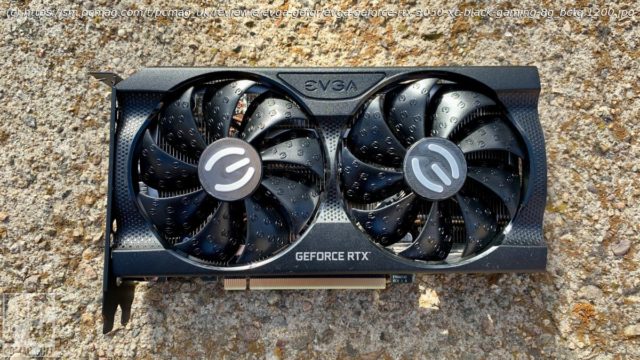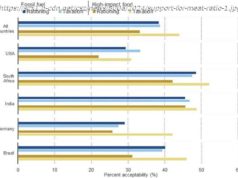The new floor for GeForce RTX cards is solid stuff
«Budget graphics card » remains an oxymoronic term here in 2022, but it all depends on where you draw the budget line. At least on list price, Nvidia is making an effort: Its GeForce RTX 3050 desktop GPU, launching today, starts with cards at an ostensible $249 list price, and it’s the new GPU that has impressed us the most in 2022 so far (mind you, of just two). We tested it in the form of EVGA’s GeForce RTX 3050 XC Black Gaming 8G, one of a host of RTX 3050 cards launching today. As a ray-tracing engine, the card performs surprisingly well, keeping price-for-performance pace with the GeForce RTX 3060, and it sometimes clears the 1440p/60-frames-per-second hurdle that many gamers aim to jump. The EVGA tops both the venerable GeForce GTX 1060 and the $159-list Nvidia GeForce GTX 1650 Super in testing almost universally, the latter a card launched in November of 2019. Its main competition, the $199 AMD Radeon RX 6500 XT that launched last week to lukewarm reviews, isn’t always as far behind as it should be, but our testing shows the RTX 3050 to be the new standing performance leader in its class. We can’t predict how much stock Nvidia’s card partners will be able to serve up. But given its Editors’ Choice-award-winning performance, we don’t expect stocks of RTX 3050 cards to last long, at least at the outset. Gamers who play at 1080p or 1440p should get one while they’re hot. The RTX Badge Takes a Step Down Until today, the lowest-end discrete desktop graphics card that you could buy from Nvidia with both Tensor and ray-tracing (RT) cores on board was the GeForce RTX 2060 Founders Edition, which originally went on sale for an MSRP of $349 back in January of 2019. This was before the full effects of the current crypto craze and the pandemic put a squeeze on GPU supply up and down the market. Today, with just inflation considered, the RTX 2060 would be a card that sells for roughly $380 in early-2022 US dollars. Of course, list prices are just a pipe dream these days, in graphics card land. On eBay, an RTX 2060 Founders Edition runs between $400 and $600, depending on the seller and the number of bids. At least on paper, that would make the MSRP of the new EVGA GeForce RTX 3050 XC Black Gaming 8G a steal at «just» $249.99. (Whether you can find one at that price from a first-party seller is another matter.) Things have gotten so constrained on the supply side even the RTX 3050’s spiritual predecessor, the GTX 1650, was recently released back onto the market in an effort by Asus to add to the available stock. So, given those market conditions, there’s a chance the RTX 3050 will end up closer to $500 or $600 given current trends at this power tier. Then again, the end to GPU supply-side squeezes may soon be in sight, as crypto prices have spent the past month collectively crashing across the board, which always affects lower-end GPUs’ prices first. As crypto prices fall, the profit viability of cards with smaller VRAM caches falls in tandem, creating a «fire sale» mentality in the mining community for all but the highest-end cards that still yield decent hash rates. A sight to behold for GPU buyers It generally takes a few months for gamers to see the cards available for purchase, as minor corrections don’t trigger immediate hardware sell-offs; we’ll need a true crypto crash for that. Just last week we saw signs that the wave may finally be cresting, though, as a variety of Radeon RX 6500 XT cards were available for almost an hour after initial launch on Newegg, opposed to the few minutes that it usually takes for bots to hoover up everything in sight. We can’t say with certainty whether this extended stay on shelves was the result of its 4GB of VRAM being unattractive to miners, or its middling gaming performance being unattractive to gamers, or just Newegg’s anti-bot measures doing their job. But whatever the case, a new GPU was available for more of an hour after launch in 2022. As bonkers as that sounds, that’s a step in the right direction, supply-wise. Speaking of low-end options lacking appeal to miners, many GPU followers out there might be asking: What, no RTX 2050? While we never saw Nvidia extend the RTX brand down into the «xx50» segment before today, now there’s some confusing news on the horizon. According to a recent report, Nvidia will be producing RTX 2050 chips, but they’re not set to release until after the RTX 3050 today. Not only that, but the RTX 2050 will be a laptop-only GPU that, stick with us, will reportedly be based on the same Nvidia GA106 die used in the RTX 3050. That doesn’t make 100% sense to us, either, but what does sanity even look like in the GPU space these days, really? The launch of the desktop version of the RTX 3050 is also odd in that it follows the laptop release by a considerable margin, launching months after the mobile RTX 3050 Ti and RTX 3060 were made available in gaming laptops from MSI (like the MSI Katana GF66 recently reviewed), Acer, and the like. MSI Katana laptop with the RTX 3060 mobile Hopefully this spec chart clears things up a bit on what we can expect out of the desktop version of the RTX 3050… The first thing you might notice is that massive transistor count. The GA106 die has proven itself immensely flexible for Nvidia, scaling all the way up to its RTX A2000 line of professional-graphics GPUs (successors to the Quadro line), down to its mobile RTX 3050 Ti and RTX 3060 line of laptop GPUs. This accounts for that 276mm^2 footprint inside such a tiny card, and although we can only speculate why Nvidia decided to include the more expensive die in such an inexpensive segment, some outlets have tried to answer the question. In almost every respect except maximum boost clock, the base specs for the GeForce RTX 3050 GPU showcase a significant lead over the AMD Radeon RX 6500 XT reference version, which shares the same specs with the Gigabyte model we benchmarked last week. Its 8GB of VRAM sits right at what many consider to be the new standard for modern PC gaming (4GB is fine, but not preferred by desktop gamers); however, that also puts it in the crosshairs of crypto miners. Last up is the power requirement, which could prove sticky for budget- or compact-PC builders with lower-rated power supplies. The GTX 1650’s rating was just 75 watts; the RTX 3050 pushes that up to 130 watts, a substantial difference that shouldn’t be overlooked if you’re not sure what sort of power limits your desktop can handle.






